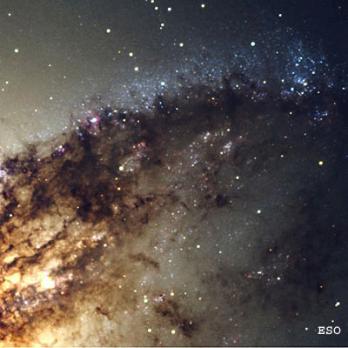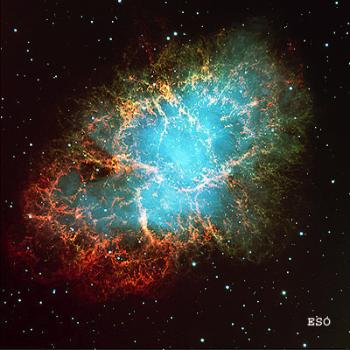Space
Reality Show -- Part II
ESO's
Very Large Telescope

The
binary star system
called AB7 packs a punch. A combined "wind" of charged particles is
perhaps a billion times more powerful than what our Sun produces. The
wind pressurizes interstellar gas to create the bubble shape

The
galaxy Centaurus A was
first identified by radio telescopes. It's between 10 million and 13
million light-years away and is thought to contain a black hole about
100 times as massive as the Sun

The
sky is strange near the
Chamaeleon I complex of bright nebulae and hot stars in the
constellation of the same name, close to the southern celestial pole

The
Dumbbell Nebula is about
1,200 light years away and packed with rarified gas that's being
ejected by the hot central star and lit by its intense ultraviolet
radiation

Cosmic
collision: Two
opposite jets from a developing star ram into interstellar matter about
1,500 light-years away in Orion, a region of intense star formation.
The enigmatic "waterfall" to the upper left is unexplained

The
famous Horsehead Nebula sits amid the Orion molecular cloud complex.
Stars behind the cosmic dust light its fringes

This
remnant of a supernova
explosion is about 6,000 light-years from Earth. It contains a neutron
star near its center that spins 30 times per second. Green light is
mostly hydrogen, and the blue light comes from electrons moving at
significant fractions of light-speed

NGC
6872, the larger galaxy,
has many bluish objects that are regions of heavy star formation. They
may have been triggered by the recent passage of smaller galaxy, IC
4970, just above the center. The bright object to the lower right is a
foreground star in our own Milky Way

Galaxy
NGC 1232, about 100
million light years away, has older reddish stars near the center while
the spiral arms are populated by young blue stars. Note the distorted
companion galaxy on the left side

NGC
3627, also known as
Messier 66, is about 35 million light years away in the constellation
Leo. Like many spiral galaxies, it has a bulge of stars at the center
swirling wound a supermassive black hole

Bright
enough to be seen
with the naked eye, the Orion nebula is a wide complex of gas and dust,
illuminated by the massive, hot Trapezium stars at its core
Catch a ride on the flying saucer back
to the Outer Space Art Gallery homepage
|
